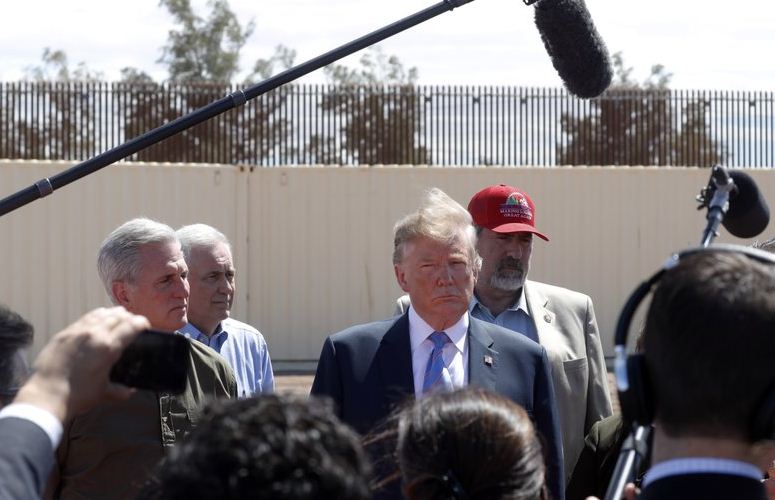WASHINGTON: When President Donald Trump insisted last year that America’s southern border was in crisis, his warnings landed with a thud.
Making unverified claims about “unknown Middle Easterners” and prayer rugs found by ranchers, Trump drew eye rolls from Democrats and many others, who derided his tactics as little more than an election-year stunt.
Now, six months later, Trump’s new cries of alarm are again being met with skepticism, though the situation at the border has indeed deteriorated. Lawmakers of both parties agree there is a genuine humanitarian emergency, with federal authorities and nonprofits unable to cope with the tens of thousands of Central American families seeking refuge in the US.
It’s a classic case of the boy who cried wolf.
No wonder the public is skeptical, says Rep. Pete Aguilar, D-Calif. “There’s a humanitarian crisis and I think that there are steps we can take to help. Unfortunately the president has never been an honest broker about any of these solutions. He plays fast and loose with the facts.”
Trump and members of his administration have spent years blaming Democrats for failing to work with them to close what they describe as “loopholes” that encourage migrants to make the dangerous trek to the US and that restrict the government’s ability to remove them once they arrive.
“Democrats in Congress must return from their Vacations and change the immigration laws, or the border, despite the great job being done by Border Patrol, will only get worse,” Trump tweeted again April 17.
But Democratic lawmakers and immigration activists say that, after years of incendiary comments and false starts, there is little appetite for cooperation with Trump on an issue that has vexed lawmakers for decades. The President, they say, has not only squandered potential goodwill, but also failed to demonstrate that he is genuinely interested in potential solutions.
Many also accuse the President of simply stoking the issue for his political benefit to energize his base and boost turnout ahead of his 2020 re-election race.
Democrats note, in particular, the President’s threat to send migrants to immigration-friendly “sanctuary cities” in an effort to punish political foes as the starkest example of why they don’t trust the administration.
“The problem is he has made it political. He’s made it all about political revenge,” said Rep. Nanette Barragan, D-Calif., who sits on the Homeland Security committee. She said that Democrats would be happy to work with the White House to address the problem, but not under the current circumstances.
“If he’s truly interested in the southern border right now and what has been happening, then these policies need to change, this rhetoric has to change,” she said.
Aguilar, the congressman from California, said that if the White House was really serious, it would propose legislative language on potential changes it wants for Congress to review and debate.
There does appear at least to be discussion underway.
Earlier this month, acting White House chief of staff Mick Mulvaney and acting Homeland Security Secretary Kevin McAleenan met with several Democratic senators to discuss border security, said an aide to No. 2 Senate Democratic leader Dick Durbin of Illinois. The aide, who spoke on condition of anonymity to describe a closed door meeting, said the talks were in early stages.
Other senators in the one-hour session included California’s Dianne Feinstein, in whose office the session was held, Jon Tester of Montana and Kyrsten Sinema of Arizona.
For the most part, critics say, Trump has instead pushed ideas that have made things worse. Those include cutting off aid money to the Central American countries that migrants are fleeing, limiting asylum claims at legal ports of entry, which encourages migrants to cross illegally elsewhere, and threatening to completely close southern border crossings, which could have the same affect.
“The problem is we’re dealing with an administration that doesn’t want a solution,” said Rep. Ruben Gallego, D-Ariz. He argued the administration could be doing far more to address the immediate crisis including incentivizing people to apply for asylum in their home countries so they don’t make the journey north, dedicating more resources to border facilities to process new arrivals and hiring more immigration judges to clear the backlog of asylum cases.
Some have also called for mobilizing FEMA and the Red Cross to help provide housing and health care as the government would in a natural disaster.
“Solutions aren’t really that hard,” Gallego said.
Meanwhile, Trump continues to portray asylum-seekers as dangerous figures trying to game the US immigration system.
“You look at some of these people; you want protection from them. And they’re saying, ‘We need protection from our country’,” Trump said. “It’s a big con job. That’s what it is.”
“Trump’s rhetoric poisons the well for any deal making,” said Frank Sharry, the executive director of America’s Voice, a liberal immigration reform group, which soured on working with Trump after he backed out of a bipartisan 2018 congressional deal that would have provided legal protection for hundreds of thousands of “dreamer” immigrants brought to the country as children and now here illegally.
“He’s leveraging chaos for political advantage,” Sharry said.
Indeed, Sharry said he has a difficult time using the word “crisis” to describe the current situation because it has become so politically charged.
“Here is an asylum emergency at the border,” he said instead.
The White House didn’t respond to requests for comment April 17. But in Africa, Ivanka Trump, the President’s daughter and senior adviser told the AP that “there is no one solution to solving this problem”.
“We have a humanitarian crisis at our southern border of epic proportion,” she said. “Ultimately it’s going to have to be done in Congress to change the laws that enable us to maintain secure borders and ensure that there’s adequate humanitarian assistance and relief for those who are struggling and seeking legitimate asylum in our country.” AP







